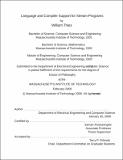Language and compiler support for stream programs
Author(s)
Thies, William Frederick, 1978-
DownloadFull printable version (3.755Mb)
Other Contributors
Massachusetts Institute of Technology. Dept. of Electrical Engineering and Computer Science.
Advisor
Saman Amarasinghe.
Terms of use
Metadata
Show full item recordAbstract
Stream programs represent an important class of high-performance computations. Defined by their regular processing of sequences of data, stream programs appear most commonly in the context of audio, video, and digital signal processing, though also in networking, encryption, and other areas. Stream programs can be naturally represented as a graph of independent actors that communicate explicitly over data channels. In this work we focus on programs where the input and output rates of actors are known at compile time, enabling aggressive transformations by the compiler; this model is known as synchronous dataflow. We develop a new programming language, StreamIt, that empowers both programmers and compiler writers to leverage the unique properties of the streaming domain. StreamIt offers several new abstractions, including hierarchical single-input single-output streams, composable primitives for data reordering, and a mechanism called teleport messaging that enables precise event handling in a distributed environment. We demonstrate the feasibility of developing applications in StreamIt via a detailed characterization of our 34,000-line benchmark suite, which spans from MPEG-2 encoding/decoding to GMTI radar processing. We also present a novel dynamic analysis for migrating legacy C programs into a streaming representation. The central premise of stream programming is that it enables the compiler to perform powerful optimizations. We support this premise by presenting a suite of new transformations. We describe the first translation of stream programs into the compressed domain, enabling programs written for uncompressed data formats to automatically operate directly on compressed data formats (based on LZ77). This technique offers a median speedup of 15x on common video editing operations. (cont.) We also review other optimizations developed in the StreamIt group, including automatic parallelization (offering an 11x mean speedup on the 16-core Raw machine), optimization of linear computations (offering a 5.5x average speedup on a Pentium 4), and cache-aware scheduling (offering a 3.5x mean speedup on a StrongARM 1100). While these transformations are beyond the reach of compilers for traditional languages such as C, they become tractable given the abundant parallelism and regular communication patterns exposed by the stream programming model.
Description
Thesis (Ph. D.)--Massachusetts Institute of Technology, Dept. of Electrical Engineering and Computer Science, 2009. This electronic version was submitted by the student author. The certified thesis is available in the Institute Archives and Special Collections. Includes bibliographical references (p. 153-166).
Date issued
2009Department
Massachusetts Institute of Technology. Department of Electrical Engineering and Computer SciencePublisher
Massachusetts Institute of Technology
Keywords
Electrical Engineering and Computer Science.